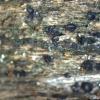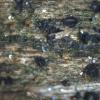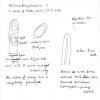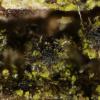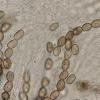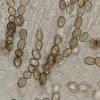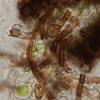
21-12-2025 21:32
Pol DebaenstHello, Garden, Burgweg 19, Veurne, BelgiumOn 10/1

21-12-2025 21:40
Isabelle CharissouBonjour, j'aimerais connaitre les références de

21-12-2025 21:31
Pol DebaenstHello, Garden, Burgweg 19, Veurne, BelgiumOn 10/1

21-12-2025 21:31
Pol DebaenstHello, Garden, Burgweg 19, Veurne, BelgiumOn 10/1

20-12-2025 23:08
Patrice TANCHAUDBonsoir, récolte sur sol sablonneux dans l'arri�

21-12-2025 09:32
Hello.A tiny ascomycete found embedded in wood in

20-12-2025 15:47
Mirek GrycHi.These grew on pine wood that was heavily covere
Helminthosphaeria ?
Václav Pouska,
18-12-2014 15:29
I collected globose hairy ascomata on a moderately decomposed lying log of Picea abies (wood surface still hard). It was in the mountain spruce forest in central Europe. I have tried to identify my collection according to the new article by Miller et al.: Phylogenetic relationships of five uncommon species of Lasiosphaeria and three new species in the Helminthosphaeriaceae (Sordariomycetes). Mycologia 106(3), 2014, pp. 505–524, but it does not seem to fit to any of those species. I attach a sketch of some micro characters, but of course, I could have missed something important. I think it may be a Helminthosphaeria rather than Echinosphaeria because it has oval one-celled spores.
Asci have a distinct top and they have eight spores arranged uniseriately. Spores are not hyaline, 11 x 5 um.
Do you think it is a described species? What features I should focus on?
Thank you
Vaclav
Jacques Fournier,
18-12-2014 15:54

Re : Helminthosphaeria ?
Hi Vaclav,
take a look at Reblova's paper in Sydowia 51 (2): 223-244, available online, that deals with other species of Helminthosphaeria resembling yours. Apical pores and septa of ascospores are diagnosic features.
Cheers,
Jacques
take a look at Reblova's paper in Sydowia 51 (2): 223-244, available online, that deals with other species of Helminthosphaeria resembling yours. Apical pores and septa of ascospores are diagnosic features.
Cheers,
Jacques
Andrew N. Miller,
18-12-2014 17:07

Re : Helminthosphaeria ?
I come to Helminthosphaeria heterotrichia very quickly in the key, but, of course, I helped develop the key... ;o)
Andy
Andy
Václav Pouska,
19-12-2014 22:25
Re : Helminthosphaeria ?
Thanks for your suggestions. The paper by Réblová lead me to the article by Samuels et al. in Mycologia 89(1), because there was not much information on H. hyphodermatis in Réblová (1999). Spore size corresponds to two species - Helminthosphaeria hyphodermiae and H. heterotricha. I think that the spores of this specimen are not hyaline - I saw an object in all spores. The appearance of perithecia is more similar to H. heterotricha than to H. hyphodermiae, and also, there does not seem to be any corticioid on the wood. If the hyalinity of spores is not a problem, viz if those I saw were not mature, I would say it can be H. heterotricha. I am not sure if I will destroy another perithecium in this specimen but I will surely look at one other specimen from that site. We also have Helminthosphaeria stuppea from there.
Václav
Václav
Björn Wergen,
15-05-2015 00:53

Re : Helminthosphaeria ?
Hi there,
I guess this recolt belongs to this topic too. The spores are hyaline only when immature, they rapidly change into pale brown. Sp 7,5-10x5-6µm, growing on wood of ?Quercus (at least deciduous wood), without any remnants of corticioid fungi, but associated with other pyrenos, lots of algae and some hyphomycetes.
How can we "field mycologists" come to H. heterotricha when the key gives us "remaining hyaline"?
regards,
björn
I guess this recolt belongs to this topic too. The spores are hyaline only when immature, they rapidly change into pale brown. Sp 7,5-10x5-6µm, growing on wood of ?Quercus (at least deciduous wood), without any remnants of corticioid fungi, but associated with other pyrenos, lots of algae and some hyphomycetes.
How can we "field mycologists" come to H. heterotricha when the key gives us "remaining hyaline"?
regards,
björn
Andrew N. Miller,
18-05-2015 22:03

Re : Helminthosphaeria ?
You should be able to use ascomata setose vs. not setose to distinguish these similar taxa.
11. Ascomata setose, asci 4–8-spored, ascospores remaining hyaline, 8–12 3 5–6 mm. . . . . . . . . . . . . . . . . . . . . . . . . . Helminthosphaeria heterotricha
11. Ascomata roughened, not setose, with or without basal mycelium . . . . . . . . . . . . . . . . . . . . . . . . . 12
12. Ascomata shiny black to metallic gray, with circular basal stroma in the substrate, ascospores brown, 8–11 3 4.5–5.5 mm . . . . . . . . Synaptospora plumbea (see Huhndorf et al. 1999)
12. Ascomata strongly roughened, dark brown to black, lacking a basal stroma, ascospores pale brown, 12–16 3 6–7 mm, surface coarsely punctate . . . . . . . . Helminthosphaeria gibberosa
Andy
11. Ascomata setose, asci 4–8-spored, ascospores remaining hyaline, 8–12 3 5–6 mm. . . . . . . . . . . . . . . . . . . . . . . . . . Helminthosphaeria heterotricha
11. Ascomata roughened, not setose, with or without basal mycelium . . . . . . . . . . . . . . . . . . . . . . . . . 12
12. Ascomata shiny black to metallic gray, with circular basal stroma in the substrate, ascospores brown, 8–11 3 4.5–5.5 mm . . . . . . . . Synaptospora plumbea (see Huhndorf et al. 1999)
12. Ascomata strongly roughened, dark brown to black, lacking a basal stroma, ascospores pale brown, 12–16 3 6–7 mm, surface coarsely punctate . . . . . . . . Helminthosphaeria gibberosa
Andy

